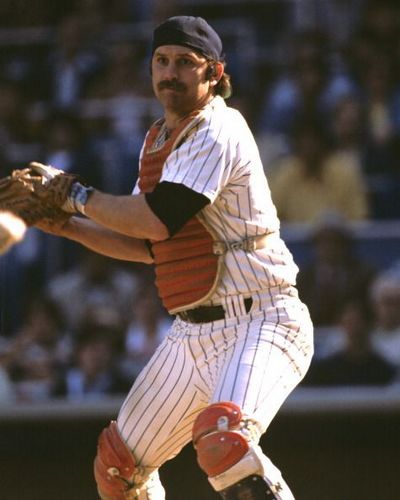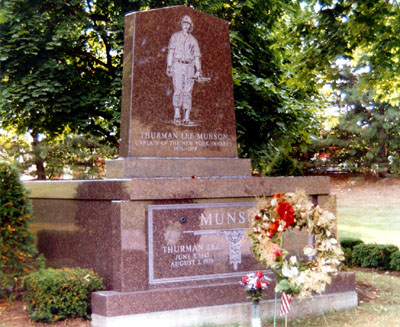Thurman Munson (Thurman Munson)

Munson was born in Akron, Ohio to Darrell Vernon Munson and Ruth Myrna Smylie, the youngest of four children. His father was a World War II veteran who became a truck driver while his mother was a homemaker. When he turned eight, the Munson family moved to nearby Canton, Ohio. He was taught how to play baseball by his older brother Duane, and usually played baseball with kids Duane’s age, who were four years older. His brother left to the United States Air Force while Thurman was a freshman in high school. He attended Lehman High School in Canton, Ohio, where he was captain of the football, baseball and basketball teams and was all-city and state in all three sports. Munson played halfback on the football squad, guard on the basketball squad, and mostly shortstop in baseball. Munson switched to catcher in his senior year in order to handle the pitching prowess of his teammate, Jerome Pruett (a fifth-round draft pick of the St. Louis Cardinals in 1965 who never reached the Major Leagues). He attracted scholarship offers from various colleges. He opted to attend nearby Kent State University on scholarship, where he was a teammate of pitcher and broadcaster Steve Stone.
In the summer of 1967, Munson joined the Cape Cod Baseball League, where he led the Chatham A’s to their first league title with a prodigious .420 batting average. In recognition of this achievement and his subsequent professional achievements, the Thurman Munson Batting Award is given each season to the League’s batting champion.
Munson was selected by the Yankees with the fourth overall pick in the 1968 Major League Baseball Draft. In his only full minor league season, he batted .301 with six home runs and 37 runs batted in for the Binghamton Triplets in their final season (1968), and made his first appearance in Yankee Stadium in August 1968, when the Triplets came to play an exhibition game against the Yankees. He was batting .363 for the Syracuse Chiefs in 1969 when he earned a promotion to the New York Yankees.
Munson made his major league debut on August 8, 1969, in the second game of a doubleheader against the Oakland Athletics. Munson went two for three with a walk, one RBI and two runs scored. Two days later, his first major league home run was the second of three consecutive home runs hit by the Yankees off Lew Krausse in a 5-1 Yankee victory over the A’s. For the season, Munson batted .256 with one home run and nine RBI. He made 97 plate appearances, but drew ten walks and had one sacrifice fly, which gave him 86 official at bats, and allowed him to go into the 1970 season still technically a rookie.
The Yankees used the pair of Jake Gibbs and Frank Fernández at catcher for most of 1969. During the off season, the Yankees dealt Fernandez to the A’s to make room for their rising star behind the plate. Munson responded by batting .302 with seven home runs and 57 RBI, and making 80 assists en route to receiving the 1970 American League Rookie of the Year award.
Munson received his first of seven All-Star nods in 1971, catching the last two innings without an at-bat. An outstanding fielder, Munson committed only one error all season. It occurred on June 18 against the Baltimore Orioles when opposing catcher Andy Etchebarren knocked Munson unconscious on a play at the plate, dislodging the ball. He also only allowed nine passed balls all season and caught 36 of a potential 59 base stealers for a stellar 61% caught stealing percentage.
Munson was known for his longstanding feud with Boston Red Sox counterpart Carlton Fisk. One particular incident that typified their feud, and the Yankees – Red Sox rivalry in general, occurred on August 1, 1973 at Fenway Park. With the score tied at 2–2 in the top of the ninth and runners on first and third, Munson attempted to score from third on Gene Michael’s missed bunt attempt. As Red Sox pitcher John Curtis let his first pitch go, Munson broke for the plate. Michael tried to bunt, and missed. With Munson coming, Fisk elbowed the Yankee shortstop out of the way and braced for Munson, who barreled into Fisk. Fisk held onto the ball, but Munson remained tangled with Fisk as Felipe Alou, who was on first, attempted to advance. The confrontation at the plate triggered a ten minute bench-clearing brawl in which both catchers were ejected.
Munson made his second All-Star team and won his first of three straight Gold Glove Awards in 1973. He also emerged as more of a slugger for the Yankees, batting .300 for the first time since 1970, and hitting a career high twenty home runs. In 1974, Munson was elected to start his first of three consecutive All-Star games, going one for three with a walk and a run scored.
Munson batted a career high .318 in 1975, which was third in the league behind Rod Carew and Fred Lynn. For the start of the 1976 season, Munson was named the first Yankees team captain since Lou Gehrig retired in 1939. He responded by batting .302 with 17 home runs and 105 RBI to receive the American League MVP Award and lead the Yankees to their first World Series since 1964. He batted .435 with three RBI and three runs scored in the 1976 American League Championship Series against the Kansas City Royals, and batted .529 with two RBI and two runs scored in the 1976 World Series against the Cincinnati Reds. Already down three games to none, Munson went four for four in the final game of the Series at Yankee Stadium to try to avoid a sweep to the “Big Red Machine.” Combined with the hits he got in his final two at bats in game three, his six consecutive hits tied a World Series record set by Goose Goslin of the Washington Senators in 1925.
Reds catcher Johnny Bench was named World Series MVP. A fairly obvious comparison of opposing backstops was made to Reds manager Sparky Anderson during the post-World Series press conference, to which, Anderson responded, “Munson is an outstanding ballplayer and he would hit .300 in the National League, but you don’t ever compare anybody to Johnny Bench. Don’t never embarrass nobody by comparing them to Johnny Bench.” Munson was visibly upset by these comments when he got on the mic shortly afterwards.
Munson batted .308 with 100 RBI in 1977, giving him three consecutive seasons batting .300 or better with 100 or more RBI each year. He was the first catcher to accomplish the feat in three consecutive years since Yankee Hall of Famer Bill Dickey’s four straight seasons from 1936-1939, matched only by Mike Piazza since (1996–1998). The Yankees repeated as American League Champions, and faced the Los Angeles Dodgers in the 1977 World Series. Munson batted .320 with a home run and three RBI in the Yankees four games to two victory over the Dodgers. The Dodgers had stolen 114 bases during the regular season, yet Munson caught four of six potential base stealers in the first four games of the series to keep the speedy Dodgers grounded in the final two.
The Yankees and Royals faced each other for the third consecutive time in the 1978 American League Championship Series. With the ALCS tied at a game apiece, and trailing 5–4 in the bottom of the eighth inning of game three, Munson hit the longest home run of his career, a 475-foot shot off Doug Bird over Yankee Stadium’s Monument Park in left-center field, to give the Yankees a 6–5 win. They won the pennant the next day, and went on to beat the Dodgers again for the 1978 World Series Championship. Munson batted .320 (8-for-25) with 7 RBI’s in this Series and also caught Ron Cey’s foul pop-up for the final out.
The Yankees had lost three in a row, and were in fourth place, eleven games behind the Baltimore Orioles in the American League East heading into the All-Star break in 1979. Despite a .297 average, the wear-and-tear of catching was beginning to take its toll on Munson, and he was overlooked for the American League All-Star team. Frequently homesick, he had a well-known desire to play for the Cleveland Indians in order to be closer to his family, and was also considering retiring at the end of the season.
Munson had been flying for over a year and purchased a Cessna Citation I/SP jet so he could fly home to his family in Canton on off-days. On August 2, 1979, he was practicing takeoffs and landings at the Akron-Canton Regional Airport with friend Jerry Anderson and flight instructor Dave Hall. On the third touch-and-go landing, Munson allowed the aircraft to sink too low before increasing engine power, causing the jet to clip a tree and fall short of the runway. The plane then hit a tree stump and burst into flames on Greensburg Rd., 870 feet short of runway 19.
Hall and Anderson both survived the accident. Hall received burns on his arms and hands, and Anderson received burns on his face, arm and neck. Munson suffered a broken neck and would have most likely been a quadriplegic had he lived. Munson died of asphyxiation due to the inhalation of superheated air and toxic substances. The FAA investigation into the crash stated that the probable cause was “…the pilot’s failure to recognize the need for, and to take action to maintain, sufficient airspeed to prevent a stall into the ground during an attempted landing. The pilot also failed to recognize the need for timely and sufficient power application to prevent the stall during an approach conducted inadvertently without flaps extended. Contributing to the pilot’s inability to recognize the problem and to take proper action was his failure to use the appropriate checklist and his nonstandard pattern procedures which resulted in an abnormal approach profile.”
Born
- June, 07, 1947
- USA
- Akron, Ohio
Died
- August, 02, 1979
- USA
- Green, Ohio
Cemetery
- Sunset Hills Burial Park
- Canton, Ohio
- USA







